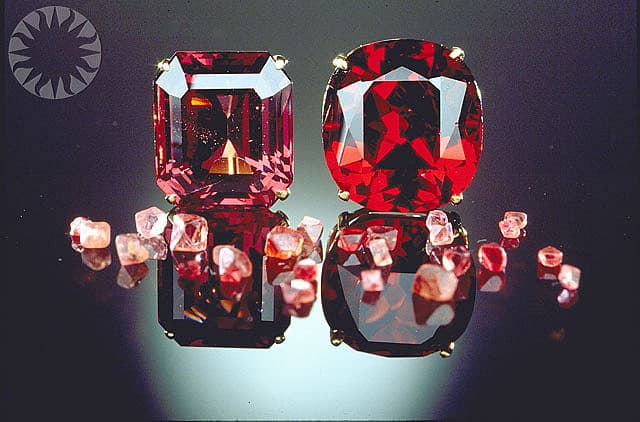Does Synthetic Spinel Exist? What is it?
The chemistry of man-made spinel can differ from natural spinel. Read more about what synthetic spinel is, how it was discovered, and what to look for.
3 Minute Read
Man-made spinel is used extensively. Discovered accidentally when scientists were experimenting to try and produce a flame-fusion blue synthetic sapphire, spinel's great advantage is that it can be made to reproduce almost all colors except purple. The blue synthetic spinel sapphire imitant is much more genuine looking than a synthetic blue spinels imitating synthetic sapphires.
Although synthetic spinel is also produced by flame-fusion, any resemblance between man-made spinel versus Verneuil rubies and sapphires or other colored corundums ends at the torch. You'll seldom see bubbles or curved striae in man-made spinel regardless of age.
Some of the imitations using man-made spinel do contain clues, though. An imitation Lapis Lazuli is made by sintering finely ground synthetic spinel and then recompacting it under pressure. Sometimes, real gold is included in the product to simulate the pyrite (fool's gold) so characteristic of natural Lapis. You can generally spot this imitation because of intensity of the color, and because this color contains an inappropriate reddish influence.
Compare the imitation, too with natural Lapis and you'll see that the luster of the imitation is much too high.
A very authentic looking moonstone imitation is also possible with man-made spinel. Colorless material is reheated long enough for some of the chemical-alumina- to separate out into small corundum crystals. This creates a cloudiness which provides the unique adularescent (the wispy, billowy, light wave) effect to the moonstone.
If the inclusions line up properly a star effect can also be produced. The star effect is often aided by thin metallic coatings on the base of the cabochon. Since it is usually a rather thin cab, there is a noticeable transparency- a good hint that man-made spinel is involved.
The star effect is easily produced in man-made spinel and man-made corundum. A good indication of imitation or synthetic is the sharp rays of the man-mades; they're just too perfect and straight. Other imitations are achieved by ruled metallic foils underneath and scribing. You can see the coatings (unless it's hidden by the mounting) or foil backs. Also, a sideview while the stone is immersed in water reveals the tell-tale transparency.
Even though man-made spinel is a popular material because of its accommodating nature in manufacture, color, and cut, it still has its shortcomings. Throughout the range of colored gems that it seeks to imitate, a practiced eye can determine that the colors are "off" just a bit from the naturally colored gems. This can be of great help in tripping you off to a man-made spinel.
IGS Note: This article was part of a series of articles that Dr. Wykoff generously allowed IGS to utilize in its library - the article is from 1989. We are in the process of publishing all of these materials for our members to utilize. We are constantly seeking to keep our library of 1,900 articles both comprehensive and accurate, and will seek to do a more comprehensive article on this topic in the near future.
We received the following comment about its contents from IGS member Jeffery Bergman at PrimaGem;
I would like to bring to your attention a serious error in your recent newsletter. The statement "There really is no such thing as a true synthetic spinel." by author Dr. Gerald L. Wykoff, GG, CSM, is incorrect. Flux growth, commercially available since the 1980's produces true synthetic spinels manufactured with a 1:1 ratio of magnesia to alumina, just like natural spinel. As a result, they will show identical RI's, SG's and polariscope reactions.
I hope you will take the time to do a bit of research, then publish a correction. A Google search of "flux grown spinel" will lead you to some GIA and SSEF lab papers on the subject.
IGS has removed the inaccurate reference identified by Jeffery Bergman, and we appreciate his diligence in pointing it out.
Dr. Gerald Wykoff GG CSM
Dr. Gerald Wykoff is GG (Graduate Gemologist), a CSM (Certified Supreme Master gemcutter), educator, and author of several gemology books. He founded the American Society of Gemcutters in the 1980s and served for more than 10 years as the editor of its monthly magazine, American Gemcutter.
Related Articles
Spinel Value, Price, and Jewelry Information
Spinel
Spinel Buying Guide
Understanding Gem Synthetics, Treatments, And Imitations, Part 4: Synthetic Gemstone Guide
Never Stop Learning
When you join the IGS community, you get trusted diamond & gemstone information when you need it.
Get Gemology Insights
Get started with the International Gem Society’s free guide to gemstone identification. Join our weekly newsletter & get a free copy of the Gem ID Checklist!
